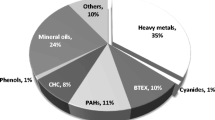The development of effective in situ and on-site bioremediation technologies can facilitate the cleanup of chemically-contaminated soil sites. Knowledge of biodegradation kinetics and the bioavailability of organic pollutants can facilitate decisions on the efficacy of in situ and on-site bioremediation of contaminated soils and determine the attainable treatment end-points. Two kinds of compounds have been studied: (1) phenol and alkyl phenols, which represent hydrophilic compounds, exhibiting high water solubility and moderate to low soil partitioning; and (2) polycyclic aromatic hydrocarbons which are hydrophobic compounds with low water solubility and exhibit significant partitioning in soil organic carbon. Representative data are given for phenol and naphthalene. The results provide support for a systematic multi-level protocol using soil slurry, wafer and porous tube or column reactors to determine the biokinetic parameters for toxic organic pollutants. Insights into bioremediation rates of soil contaminants in compact soil systems can be attained using the protocol.
Similar content being viewed by others
Author information
Authors and Affiliations
Additional information
Received 04 December 1995/ Accepted in revised form 31 January 1997
Rights and permissions
About this article
Cite this article
Tabak, H., Govind, R. Protocol for determining bioavailability and biokinetics of organic pollutants in dispersed, compacted and intact soil systems to enhance in situ bioremediation. J Ind Microbiol Biotech 18, 330–339 (1997). https://doi.org/10.1038/sj.jim.2900394
Issue Date:
DOI: https://doi.org/10.1038/sj.jim.2900394




